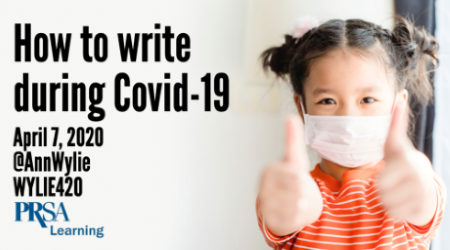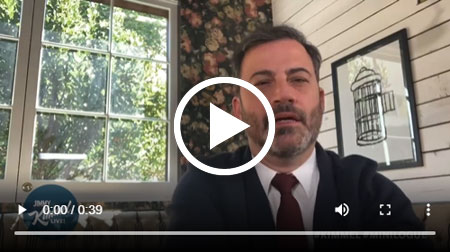Free webinar on demand, find the right tone & more
Here are 7 more tips on writing during the Covid-19 pandemic.
- Couldn’t make last week’s webinar?
- Find the right tone.
- Picture your readers’ lives.
- What do your readers need from you now?
- Ask, “What business objective are we addressing with this content?”
- Ask, “How do you see this reflecting our brand?”
- Share John Armato’s “Six Things to Consider Before You Send That Blast Email Update …”: See especially: If you don’t have anything to say, don’t say anything. 3. Stay in your lane. 4. Now’s not the time for “on a lighter note …”
- Remember, your audience members have access to all of the light, fluffy content they want. Why would they want it from you? Unless you can bring me the original cast of Hamilton via Zoom, I’d rather get mine from Jim Krasinski.
- Are you over-communicating?
- Keep paragraphs short.
- How are you spending your isolation?
“How to Write During Covid-19” — a free webinar from PRSA and me — is now available on demand, from April 14 for however long it’s helpful. Watch it free with coupon code WYLIE420.

One way to make your crisis communications messages more compassionate is to find the right tone.
I’m all for a little extra warmth in messages right now. But this message, from Marriott, feels overwrought to me:
“… [W]e’ve all borne witness to how this insidious virus is impacting our families, our communities and our very way of life. What we’re facing is daunting, but I am heartened by the moments of triumph in everyday acts of courage, humanity and love. Although these are trying times for us all, I remain optimistic that our world will thrive once again.” …
“Marriott understands that the pulse of the world beats as one to overcome COVID-19 and its devastating impact around the globe.”
What’s the problem here?
Notice that this message focuses on the sender (I am heartened, I remain, Marriott understands) instead of on the reader.
It’s easy to read, but I’m irritated by all of the adjectives (insidious, very, daunting, everyday, trying, optimistic, devastating). When was the last time you said “borne witness” on an elevator? It feels more like a sermon than a corporate message. I worry that all of these feelings will distract the sender from washing his hands.
I’d move a little closer to the Keep-Calm-And-Carry-On end of the voice spectrum for this piece.
What do you think?
Another way to make your crisis communications more compassionate is to picture your readers’ lives.
Joshua Hafner shares this quote from Time magazine:
“It’s tricky when people’s circumstances vary so widely, from bored-and-alone to overwhelmed-with-toddlers-and-deadlines to abruptly-unemployed. What might be offending for one consumer might be just the right message for another.”
Agreed.
If you have a way to segment your audience into these categories — or if you know which segment your audience belongs to — send targeted messages to each segment.
If not, do your best. Just being able to picture your audience members’ lives will make your content more compassionate.
“My team keeps pressuring me to post light fluffy content on social media,” writes a webinar attendee. “I don’t feel this is appropriate given Covid-19 and the fact that we’re a health system. How do I push back?”
Oy! Sorry to hear it. I sure don’t want my health system to be wasting my time or its own with cat videos right now.
Here are some conversation starters:
What do you think? Is fluff appropriate in this situation? If not, how would you push back?
The mandate of crisis communications is to communicate early and often. But when literally every person — and every organization — in the world is affected by the pandemic, that adds up to a lot of email.
For perspective, let’s hear what Jimmy Kimmel has to say about that:
Lisa Stage, thank you for bringing this to my attention!
Every day, long paragraphs get skipped by busy readers in a hurry. During a crisis, long paragraphs may also look as if you’re hiding something. Here’s a honker, at 161 words, from that Marriott message:
Given the unprecedented disruption to the travel industry, a number of our hotels have, unfortunately, had to close temporarily. Even as the hotels were shutting their doors, associates from New Delhi, India to Santos, Brazil, have found multiple ways to support the communities in which the hotels are located. The Riviera Marriott Hotel La Porte de Monaco and AC Hotel Nice, for example, donated all of their unused produce and food products to a local children’s charity, which provides housing and other services for endangered children. Many of our properties have contributed by providing food, pre-packed and cooked meals to crisis relief efforts and much-needed supplies like cleaning products, masks, gloves, anti-microbial wipes, sanitizers and shower caps for medical and other frontline workers. And in a beautiful sign of solidarity among us all, many of our teams have illuminated their hotel windows with symbols of love and messages of hope (some of these images are at the top of this email.)
Solution: Hit return more often. Or, in this case, how about breaking it with bullets?
Want more tips for making messages more readable and credible, during a crisis or not?
I presented five online courses last week — both in-house workshops and public webinars.
Would you like to bring your team together online to become better writers? Let’s talk.
And, for your next virtual happy hour or Zoom coffee break, here’s Tom Ford on how to look good on screen.
What do you need from me during the pandemic? Please send me your questions, examples and ideas. I’ll try to address them in the next issue.
In the meantime, stay happy, stay healthy and stay sane!
